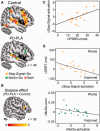Selective serotonin reuptake inhibition modulates response inhibition in Parkinson's disease
- PMID: 24578545
- PMCID: PMC3959561
- DOI: 10.1093/brain/awu032
Selective serotonin reuptake inhibition modulates response inhibition in Parkinson's disease
Abstract
Impulsivity is common in Parkinson's disease even in the absence of impulse control disorders. It is likely to be multifactorial, including a dopaminergic 'overdose' and structural changes in the frontostriatal circuits for motor control. In addition, we proposed that changes in serotonergic projections to the forebrain also contribute to response inhibition in Parkinson's disease, based on preclinical animal and human studies. We therefore examined whether the selective serotonin reuptake inhibitor citalopram improves response inhibition, in terms of both behaviour and the efficiency of underlying neural mechanisms. This multimodal magnetic resonance imaging study used a double-blind randomized placebo-controlled crossover design with an integrated Stop-Signal and NoGo paradigm. Twenty-one patients with idiopathic Parkinson's disease (46-76 years old, 11 male, Hoehn and Yahr stage 1.5-3) received 30 mg citalopram or placebo in addition to their usual dopaminergic medication in two separate sessions. Twenty matched healthy control subjects (54-74 years old, 12 male) were tested without medication. The effects of disease and drug on behavioural performance and regional brain activity were analysed using general linear models. In addition, anatomical connectivity was examined using diffusion tensor imaging and tract-based spatial statistics. We confirmed that Parkinson's disease caused impairment in response inhibition, with longer Stop-Signal Reaction Time and more NoGo errors under placebo compared with controls, without affecting Go reaction times. This was associated with less stop-specific activation in the right inferior frontal cortex, but no significant difference in NoGo-related activation. Although there was no beneficial main effect of citalopram, it reduced Stop-Signal Reaction Time and NoGo errors, and enhanced inferior frontal activation, in patients with relatively more severe disease (higher Unified Parkinson's Disease Rating Scale motor score). The behavioural effect correlated with the citalopram-induced enhancement of prefrontal activation and the strength of preserved structural connectivity between the frontal and striatal regions. In conclusion, the behavioural effect of citalopram on response inhibition depends on individual differences in prefrontal cortical activation and frontostriatal connectivity. The correlation between disease severity and the effect of citalopram on response inhibition may be due to the progressive loss of forebrain serotonergic projections. These results contribute to a broader understanding of the critical roles of serotonin in regulating cognitive and behavioural control, as well as new strategies for patient stratification in clinical trials of serotonergic treatments in Parkinson's disease.
Keywords: Parkinson’s disease; citalopram; functional MRI; response inhibition; serotonin.
Figures




Similar articles
-
Atomoxetine restores the response inhibition network in Parkinson's disease.Brain. 2016 Aug;139(Pt 8):2235-48. doi: 10.1093/brain/aww138. Epub 2016 Jun 24. Brain. 2016. PMID: 27343257 Free PMC article. Clinical Trial.
-
Improving response inhibition in Parkinson's disease with atomoxetine.Biol Psychiatry. 2015 Apr 15;77(8):740-8. doi: 10.1016/j.biopsych.2014.01.024. Epub 2014 Feb 7. Biol Psychiatry. 2015. PMID: 24655598 Free PMC article. Clinical Trial.
-
Improving response inhibition systems in frontotemporal dementia with citalopram.Brain. 2015 Jul;138(Pt 7):1961-75. doi: 10.1093/brain/awv133. Epub 2015 May 21. Brain. 2015. PMID: 26001387 Free PMC article. Clinical Trial.
-
[Escitalopram: a selective inhibitor and allosteric modulator of the serotonin transporter].Encephale. 2007 Dec;33(6):965-72. doi: 10.1016/j.encep.2007.11.001. Epub 2007 Dec 11. Encephale. 2007. PMID: 18789789 Review. French.
-
Cross-species studies of cognition relevant to drug discovery: a translational approach.Br J Pharmacol. 2017 Oct;174(19):3191-3199. doi: 10.1111/bph.13826. Epub 2017 May 24. Br J Pharmacol. 2017. PMID: 28432778 Free PMC article. Review.
Cited by
-
Effects of whole-body vibration training on lower limb motor function and neural plasticity in patients with stroke: protocol for a randomised controlled clinical trial.BMJ Open. 2022 Jun 28;12(6):e060796. doi: 10.1136/bmjopen-2022-060796. BMJ Open. 2022. PMID: 35768103 Free PMC article.
-
Atomoxetine restores the response inhibition network in Parkinson's disease.Brain. 2016 Aug;139(Pt 8):2235-48. doi: 10.1093/brain/aww138. Epub 2016 Jun 24. Brain. 2016. PMID: 27343257 Free PMC article. Clinical Trial.
-
Connectivity of the Frontal Cortical Oscillatory Dynamics Underlying Inhibitory Control During a Go/No-Go Task as a Predictive Biomarker in Major Depression.Front Psychiatry. 2020 Aug 3;11:707. doi: 10.3389/fpsyt.2020.00707. eCollection 2020. Front Psychiatry. 2020. PMID: 32848905 Free PMC article.
-
Dopaminergic modulation of motor network dynamics in Parkinson's disease.Brain. 2015 Mar;138(Pt 3):664-78. doi: 10.1093/brain/awu381. Epub 2015 Jan 6. Brain. 2015. PMID: 25567321 Free PMC article.
-
Co-Occurrence of Apathy and Impulsivity in Progressive Supranuclear Palsy.Mov Disord Clin Pract. 2021 Sep 16;8(8):1225-1233. doi: 10.1002/mdc3.13339. eCollection 2021 Nov. Mov Disord Clin Pract. 2021. PMID: 34761056 Free PMC article.
References
-
- Agnoli L, Carli M. Dorsal-striatal 5-HT2A and 5-HT2C receptors control impulsivity and perseverative responding in the 5-choice serial reaction time task. Psychopharmacology (Berl) 2012;219:633–45. - PubMed
-
- Anderson IM, Clark L, Elliott R, Kulkarni B, Williams SR, Deakin JF. 5-HT(2C) receptor activation by m-chlorophenylpiperazine detected in humans with fMRI. Neuroreport. 2002;13:1547–51. - PubMed
-
- Arnone D, Horder J, Cowen PJ, Harmer CJ. Early effects of mirtazapine on emotional processing. Psychopharmacology (Berl) 2009;203:685–91. - PubMed
Publication types
MeSH terms
Substances
Grants and funding
LinkOut - more resources
Full Text Sources
Other Literature Sources
Medical

